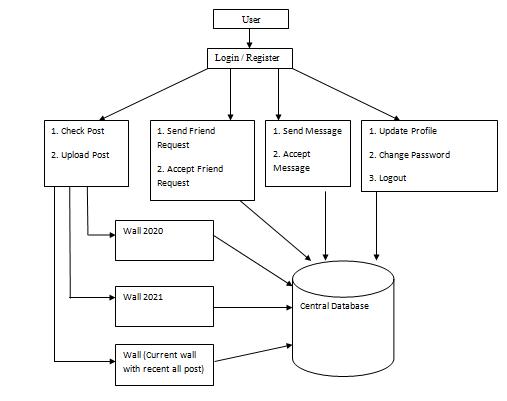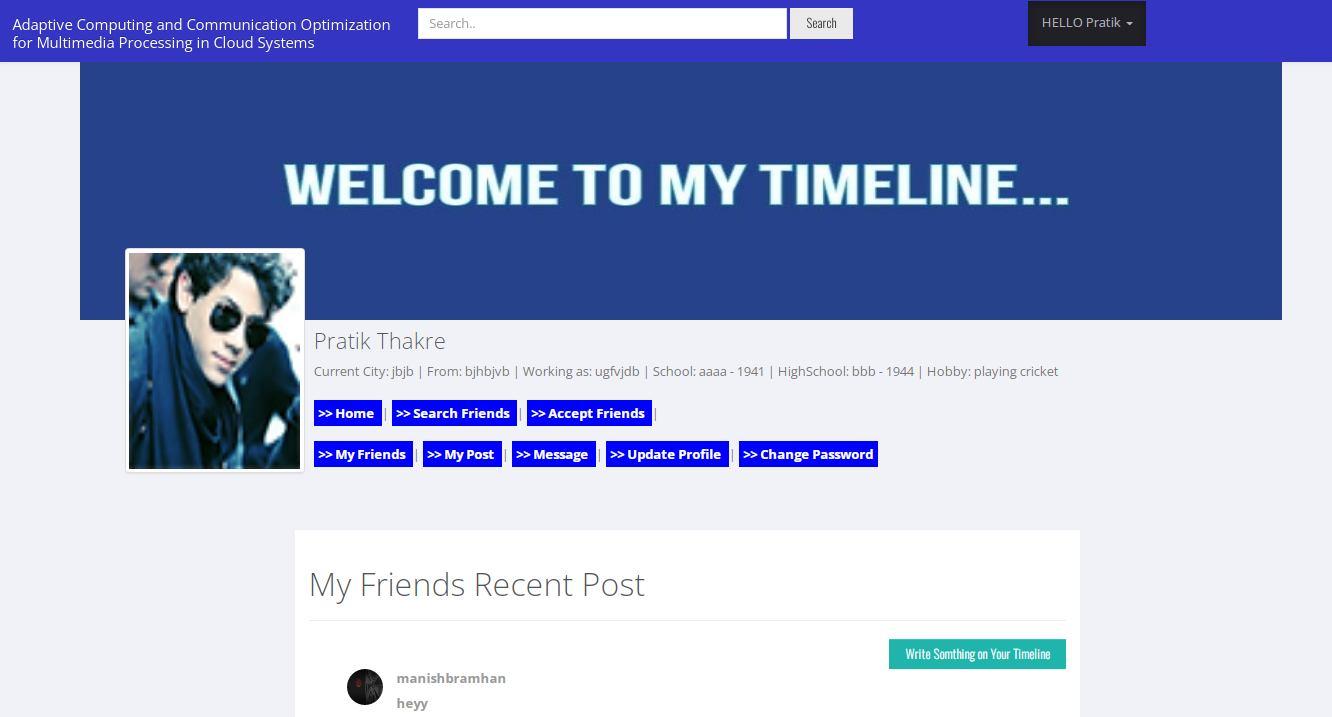
ISSN: 2321 9653; IC Value: 45.98; SJ Impact Factor: 7.538

Volume 10 Issue XI Nov 2022 Available at www.ijraset.com


ISSN: 2321 9653; IC Value: 45.98; SJ Impact Factor: 7.538

Volume 10 Issue XI Nov 2022 Available at www.ijraset.com

1
Kiran Bhimrao Dabhade2
, C. M. Mankar1, 2
Department of Computer Science and Engineering, Sant Gadge Baba Amravati UniversityAbstract: Cloud data centers become more and more powerful, energy consumption becomes a major challenge both for environmental concerns and for economic reasons, Towards this aim, we present model of social network website and will optimize server in such way that old data server should run on minimum cost. Also this implementation finds out the pattern of data consuming of users and according to that the graphs get generated. And after generating user data consumption data patterns optimize server in such way that whichever server data have less traffic should stay on sleep mode.
Keywords: cloud, data saver, energy consumption, adaptive computing, multimedia processing
Internet based services are evolving towards an ever increasing amount of multimedia content, both in terms of number of resources and of their size. This trend determines an evolution towards workloads characterized by significantly increased computational and communication requirements and higher variability, with major fluctuations throughout the day. To cope with such demands, the basic motivation behind this implementation is to present a promising approach, because it provides an elastic, pay as you go pricing model that can be used to address workload fluctuations, while the large data centers, that are typical of cloud infrastructures, can provide the computational power required to manage the huge amount of multimedia data of modern applications.
In previous few years multimedia applications are recognized to represent a significant challenge for cloud computing systems [11] as a result of they place great overhead not solely on cpu and storage needs, additionally conjointly on the communication infrastructure. Recently, most studies within the field have projected solutions that enable mobile devices to access multimedia made applications by offloading the computing intensive tasks on the cloud servers [12], [13]. These works target delivering top quality multimedia services that may guarantee the agreed QoS and save energy on the mobile devices to extend their lifespan. However, they are doing not take into account the energy related problems at the info center level, that square measure significantly difficult within the context of multimedia applications requiring high amounts of cpu and bandwidth resources. Most of the prevailing approaches for energy saving in cloud data center specialise in scheduling jobs between computing servers and providing energy potency by suggests that of some hardware techniques, like DVFS [8], [10], [14], [15]. Schedulers that exploit this feature are classified in [16] as static and sequential.
ISSN: 2321 9653; IC Value: 45.98; SJ Impact Factor: 7.538 Volume 10 Issue XI Nov 2022 Available at www.ijraset.com

Cloud data centers become more and more powerful, energy consumption becomes a major challenge both for environmental concerns and for economic reasons, Hence we have implemented the model to save server running cost which is social network website. Fig. 1 shows data flow diagram of optimized version. First of all users have to do registration first and then they are able to do the authentication. Then users are able to do all the operations. Here the data get stored on server in optimized form such as the current wall consists of all the recent post. And the wall 2020 and wall 2021 consist of old posts where fig. 2 shows un optimized version the data get stored on server in un optimized form such as the wall consists of all the post.

Fig. 3: Home Page

Fig. 4: Un optimize version home page


ISSN: 2321 9653; IC Value: 45.98; SJ Impact Factor: 7.538

Volume 10 Issue XI Nov 2022 Available at www.ijraset.com
Fig. 5: Un optimize Version Wall




Fig. 6: Optimized version home page

ISSN: 2321 9653; IC Value: 45.98; SJ Impact Factor: 7.538

Volume 10 Issue XI Nov 2022 Available at www.ijraset.com
Fig. 7: Optimize Version wall 1




Fig. 8: Optimize Version wall 2

ISSN: 2321 9653; IC Value: 45.98; SJ Impact Factor: 7.538

Volume 10 Issue XI Nov 2022 Available at www.ijraset.com
Figure 3 shows Home Page which contain links of all the thee modules in which Optimize Version contain social media network have optimize backend server which will save overall running cost of electricity which will lead to the green revolution . Then Un optimize Version contain social media network which have un optimize backend server which will not save overall running cost of electricity which will not lead to the green revolution. And then Admin Panel will show comparison between optimize cloud social media and un optimize cloud social media. Figure 4 shows the home page of Un optimize version. It consists of two buttons one is registration button and another is login button. Then figure 5 shows Un optimize Version Wall. Once authentication of user completed, user wall is open. It consists of all the data that are posted by user’s friend. User wall consists of some buttons and they are: home, search friend, accept friend request, my posts etc. where Figure 6 shows the home page of an optimize version. It consists of two buttons one is registration button and another is login button. Then figure 7 and figure 8 shows walls of optimized version where wall 1 is divided into multiple database server. These posts comes from main server. And wall 2 where wall is divided into multiple database server. These posts comes from older wall database server where user request less here. So we put all those wall data in other database server so that main server needs to process less as comparative to the Un optimize version. Then Figure 9 shows result which is comparison graph of optimized and un optimized cloud. Here graph 1 server idle state in optimized cloud and graph 2 shows server idle state in un optimized cloud.
Cloud data centers become more and more powerful, energy consumption becomes a major challenge both for environmental concerns and for economic reasons, to address this problem, this dissertation proposed a model of social network website in which three modules are implemented named as optimized version, un optimized version and admin section. In optimized version server get optimized in such way that old data server should run on minimum cost. And in un optimized version the data server should run on maximum cost. Also we find out the pattern of data consuming users and according to that the graphs get generated.


[1] C. Canali, M. Colajanni, and R. Lancellotti, “Performance evolution of mobile web based services,” Internet Computing, IEEE, vol. 13, no. 2, pp. 60 68, 2009.
[2] EPA, “Report to congress on server and data center energy efficiency,” US Environmental Protection Agency, Tech. Rep., 2007.
[3] J. Whitney and P. Delforge, “Data center efficiency assessmenty scaling up energy efficiency across the data center industry: Evaluating key drivers and barriers,” NRDC, Anthesis, Tech. Rep., 2014, http://www.nrdc.org/energy/files/datacenter efficiency assessment IP.pdf.
[4] M. Alizadeh, T. Edsall, S. Dharmapurikar, R. Vaidyanathan, K. Chu, A. Fingerhut, F. Matus, R. Pan, N. Yadav, G. Varghese et al., “Conga: Distributed congestion aware load balancing for datacenters,” in SIGCOMM’14. ACM, 2014, pp. 503 514.
[5] H. Wang and C. Schmid, “Action recognition with improved trajectories,” in Proceedings of the IEEE International Conference on Computer Vision, 2013, pp. 3551 3558.
[6] R. Girshick, J. Donahue, T. Darrell, and J. Malik, “Rich feature hierarchies for accurate object detection and semantic segmentation,” in Proceedings of the IEEE conference on computer vision and pattern recognition, 2014, pp. 580 587.
[7] M. S. Hossain, G. Muhammad, M. F. Alhamid, B. Song, and K. AlMutib, “Audio visual emotion recognition using big data towards 5g,” Mobile Networks and Applications, pp. 1 11, 2016.
ISSN: 2321 9653; IC Value: 45.98; SJ Impact Factor: 7.538 Volume 10 Issue XI Nov 2022 Available at www.ijraset.com

[8] J. W. Jiang, T. Lan, S. Ha, M. Chen, and M. Chiang, “Joint VM placement and routing for data center traffic engineering,” in INFOCOM’12. IEEE, 2012, pp. 2876 2880.
[9] R. Brown et al., “Report to congress on server and data center energy efficiency: Public law 109 431,” Lawrence Berkeley National Laboratory, 2008.
[10] R. Urgaonkar, U. C. Kozat, K. Igarashi, and M. J. Neely, “Dynamic resource allocation and power management in virtualized data centers,” in NOMS’10. IEEE, 2010, pp. 479 486.
[11] W. Zhu, C. Luo, J. Wang, and S. Li, “Multimedia Cloud Computing,” IEEE Signal Processing Magazine, vol. 28, no. 3, pp. 59 69, May 2011.
[12] S. Wang and S. Dey, “Adaptive Mobile Cloud Computing to Enable Rich Mobile Multimedia Applications,” IEEE Transactions on Multimedia, vol. 15, no. 4, pp. 870 883, 2013.
[13] Y. W. Ma, J. L. Chen, C. H. Chou, and S. K. Lu, “A Power Saving Mechanism for Multimedia Streaming Services in Cloud Computing,” IEEE Systems Journal, vol. 8, no. 1, pp. 219 224, March 2014.
[14] V. Mathew, R. K. Sitaraman, and P. Shenoy, “Energy aware load balancing in content delivery networks,” in INFOCOM, 2012 Proceedings IEEE. IEEE, 2012, pp. 954 962.
[15] D. Kusic, J. O. Kephart, J. E. Hanson, N. Kandasamy, and G. Jiang, “Power and performance management of virtualized computing environments via lookahead control,” Cluster computing, vol. 12, no. 1, pp. 1 15, 2009.
[16] A. Beloglazov, R. Buyya, Y. C. Lee, A. Zomaya et al., “A taxonomy and survey of energy efficient data centers and cloud computing systems,” Advances in computers, vol. 82, no. 2, pp. 47 111, 2011.
[17] S. Wang, A. Zhou, C. H. Hsu, X. Xiao, and F. Yang, “Provision of data intensive services through energy and qos aware virtual machine placement in national cloud data centers,” IEEE Transactions on Emerging Topics in Computing, vol. 4, no. 2, pp. 290 300, 2016.
